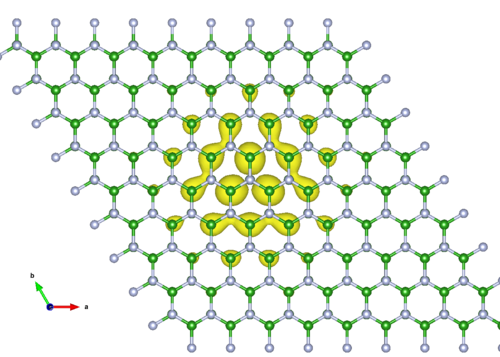Plotting exciton wavefunction: Difference between revisions
(Created page with "The exciton wavefunction can be written as <math>\psi_\lambda\left(r_e,r_h\right)=\sum_{vc} A_{vc}^\lambda \psi_v(r_h)\psi_c^*(r_e)</math> and depends on coordinates of a hole as well as an electron, thus two coordinates. In order to represent this function in 3D space we need to fix either the position of the electron $\psi_\lambda(r^*_e,r_h)$ or that of the hole $\psi_\lambda(r_e,r^*_h)$ File:HBN exciton.png|500px|thumb|Charge density of the first bright exciton...") |
No edit summary |
||
| Line 1: | Line 1: | ||
The exciton wavefunction can be written as <math>\psi_\lambda | The wavefunction of an exciton is instrumental for analyzing the symmetry, position, and localization of the state. | ||
The exciton wavefunction can be written as <math>\psi_\lambda(r_e,r_h)=\sum_{vc} A_{vc}^\lambda \psi_v(r_h)\psi_c^*(r_e)</math> depends on coordinates of a hole as well as an electron, thus two coordinates. In order to represent this function in 3D space we need to fix either the position of the electron </math>\psi_\lambda(r^*_e,r_h)</math> or that of the hole <math>\psi_\lambda(r_e,r^*_h)</math> | |||
VASP can compute the charge density of a particular exciton state, i.e., <math>\rho_\lambda(r)=\psi_\lambda(r^*_e,r_h)\psi^*_\lambda(r^*_e,r_h)</math> or <math>\rho_\lambda(r)=\psi_\lambda(r_e,r^*_h)\psi^*_\lambda(r_e,r^*_h)</math>, and writes the resulting charge density into CHGCAR.XX files, where XX stands for the index <math>\lambda</math> of the eigenvector. VASP computes the charge density by transforming the cell with k-points into a supercell. Thus, the exciton charge density is written for a supercell of dimensions <math>{\rm NKX}\times{\rm NKX}\times{\rm NKX}</math>. | |||
Since the exciton charge density is represented in the supercell, the size of CHGCAR.XX files can be quite large. It can be estimated by <math>(NGX*NKX)*(NGX*NKX)*(NGX*NKX)*18</math> bytes. | |||
The position of the fixed particle is provided in direct (fractional) coordinates by tags {{TAG|BSEHOLE}} or {{TAG|BSEELECTRON} for a hole or an electron, respectively. The tag {{TAG|NBSEEIG}} sets the number of excitons wavefunction that are computed. | |||
# How to fix the position of the particle: | |||
When fixing the position of the particle it is important to make sure that the hole or electron is not fixed exactly at the center of an atom or in the node of the wavefunction, which can lead to wrong results. Thus, make sure to shift the fixed coordinate slightly away from the atom. Furthermore, the wavefunction of the fixed particle is taken at the nearest G-vector, whose exact position is written in the {{FILE|OUTCAR}} file (hole/electron position is fixed at: ). | |||
The exciton charge density only accounts for the plane-wave part of the wave function, thus, all the augmentation terms are not accounted for. | |||
# Degenerate states: | |||
The calculated excitonic states can be degenerate, i.e., multiple eigenvectors have the same energy, thus, it is important to add together all the degenerate states to be able to analyze the exction. | |||
# Example: | |||
In the provided example, the exciton char | |||
Revision as of 15:25, 29 January 2024
The wavefunction of an exciton is instrumental for analyzing the symmetry, position, and localization of the state.
The exciton wavefunction can be written as depends on coordinates of a hole as well as an electron, thus two coordinates. In order to represent this function in 3D space we need to fix either the position of the electron </math>\psi_\lambda(r^*_e,r_h)</math> or that of the hole
VASP can compute the charge density of a particular exciton state, i.e., or , and writes the resulting charge density into CHGCAR.XX files, where XX stands for the index of the eigenvector. VASP computes the charge density by transforming the cell with k-points into a supercell. Thus, the exciton charge density is written for a supercell of dimensions .
Since the exciton charge density is represented in the supercell, the size of CHGCAR.XX files can be quite large. It can be estimated by bytes.
The position of the fixed particle is provided in direct (fractional) coordinates by tags BSEHOLE or {{TAG|BSEELECTRON} for a hole or an electron, respectively. The tag NBSEEIG sets the number of excitons wavefunction that are computed.
- How to fix the position of the particle:
When fixing the position of the particle it is important to make sure that the hole or electron is not fixed exactly at the center of an atom or in the node of the wavefunction, which can lead to wrong results. Thus, make sure to shift the fixed coordinate slightly away from the atom. Furthermore, the wavefunction of the fixed particle is taken at the nearest G-vector, whose exact position is written in the OUTCAR file (hole/electron position is fixed at: ).
The exciton charge density only accounts for the plane-wave part of the wave function, thus, all the augmentation terms are not accounted for.
- Degenerate states:
The calculated excitonic states can be degenerate, i.e., multiple eigenvectors have the same energy, thus, it is important to add together all the degenerate states to be able to analyze the exction.
- Example:
In the provided example, the exciton char

Related tags and sections
CHGCAR, NBSEEIG, BSEHOLE, BSEELECTRON, BSE
